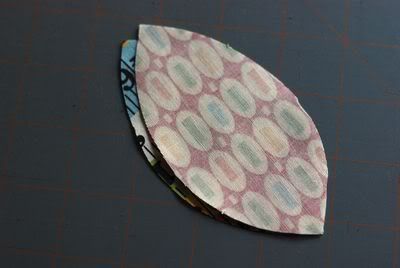I had one of those moments in Target the other day while walking (well running, actually, as I had a screaming toddler in my cart) by an endcap, and instinctively, reflexively even, bent down and grabbed this fantastic cake platter as we sped past. The first thing that popped into my head to describe it was "Barnyard Chic" -- check out the chicken wire detail on the foot! Completely fantastic --
Posted by retro mama
Driving home, this strange urge to make Easter eggs came over me. Strange in that I don't usually get this kind of inspiration until either, a) after the holiday has passed, or b) it's so close to the holiday that there isn't enough time to complete the project. In any case, not only did I finish the eggs in time, but I've come up with a little tutorial (my first!) far enough in advance for anyone else who wants to make fabric Easter eggs, too. These are just a bit bigger than real eggs and a terrific way to use up those fabric scraps! Please be sure to tell me if you have any trouble printing the pattern (it should be 2-1/8"W by 4-1/4"h) or if any of the instructions are confusing so I can fix them!
Fabric Easter Egg Tutorial
Materials:
10"w x 5"h Quilting cotton, linen or other non-stretchy woven fabric in one or more prints
Thread
Fiberfill, Nature-fill or other similar polyester or natural stuffing
Disappearing Ink Pen
Scissors
Pins
Hand sewing needle
Pattern (I recommend printing it on card stock for easy tracing)
Seam allowances are 1/4"
1. Cut out the pieces. Place pattern piece perpendicular to the fabric selvedge, trace the pattern with disappearing ink (see photo below) and cut four pieces from desired fabric prints. You may cut multiple pieces simultaneously from the same print by folding the fabric over one or more times, cutting up to 4 pieces at once. (Tip: If you're using a scrap and don't know which way the selvedge is, test which direction the fabric is stretchiest. The fabric is stretchier going perpendicular to the selvedge, and less stretchy going parallel with the selvedge; you want the stretch going from top to bottom of the egg, not side to side, so your egg doesn't get too "fat" when you stuff it. Hopefully that makes sense.)

2. Place pieces together for sewing. Always keeping track of which end is "up", place 2 fabric pieces, right sides together, pinning if desired. Do the same with the remaining two pieces. Transfer the two dots from the pattern to the fabric pieces on top. If using two different fabrics, make sure both pairs have one of each print and that the same print is on the top of both sets.

3. Sew a seam along the right side of one set of egg pieces, from top dot to bottom dot, backstitching at the top and bottom. Do the same with the second set of pieces.

4. Put the two halves together. Turn one set of egg pieces right side out, and place inside the other set of egg pieces, so that right sides are together on the inside.

Match the seams at the top and bottom and pin. (Note the purple ink marks on the lower righthand side in the photo below that indicate where I will leave a hole for stuffing)

5. Sew the two halves together. Sew around the outside edge of the egg, leaving a 1" hole on one side for turning and stuffing, backstitching at the beginning and end of the seam.
6. Trim the seam allowances, taking care not to snip into the stitches and leaving the seam allowances wide around the open hole.
7. Turn the egg right side out through the hole and it will look something like this

8. Stuff the egg firmly with poly-fill or other stuffing, and close the hole with small slip stitches/ladder stitches.

9. Voila! You have a completed egg.

10. Now make bunches and bunches of these and post your photos in my newflickr group dedicated to projects made with my patterns!
I hope you have as much fun making these as I did!



No comments:
Post a Comment